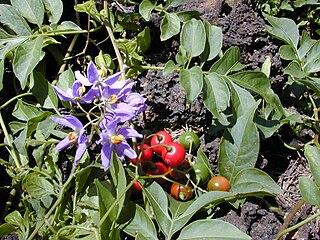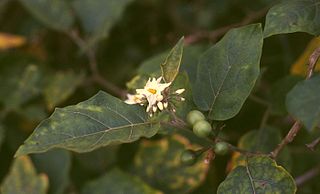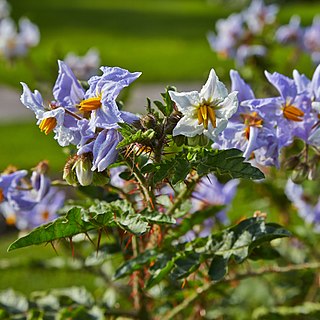
Eggplant, aubergine or brinjal is a plant species in the nightshade family Solanaceae. Solanum melongena is grown worldwide for its edible fruit.

Solanum is a large and diverse genus of flowering plants, which include three food crops of high economic importance, the potato, the tomato and the eggplant. It also contains the nightshades and horse nettles, as well as numerous plants cultivated for their ornamental flowers and fruit.

Solanum dulcamara, also known as bittersweet, bittersweet nightshade, bitter nightshade, blue bindweed, Amara Dulcis, climbing nightshade, fellenwort, felonwood, poisonberry, poisonflower, scarlet berry, snakeberry, trailing bittersweet, trailing nightshade, violet bloom, or woody nightshade, is a species of vine in the potato genus Solanum, family Solanaceae. It is native to Europe and Asia, and widely naturalised elsewhere, including North America, where it is an invasive problem weed.

Solanum mauritianum is a small tree or shrub native to South America, including Northern Argentina, Southern Brazil, Paraguay and Uruguay. It has become a widespread invasive weed in Azores Islands, Cook Islands, Fiji, Hawai‘i, New Caledonia, Norfolk Island, Solomon Islands, Tonga, Réunion Island, Mauritius, Madagascar, Australia, New Zealand, India, Sri Lanka and several southern African countries. Its common names include earleaf nightshade, woolly nightshade, flannel weed, bugweed, tobacco weed, tobacco bush, wild tobacco and kerosene plant.

Solanum pseudocapsicum is a nightshade species with mildly poisonous fruit. It is commonly known as the Jerusalem cherry, Madeira winter cherry, or, ambiguously, "winter cherry". These perennials can be grown decoratively as house plants, but in some areas of South Africa, India, Australia and New Zealand it is regarded as a weed.

Solanum aethiopicum, the bitter tomato, Ethiopian eggplant, or nakati, is a fruiting plant of the genus Solanum mainly found in Asia and Tropical Africa. It is also known as Ethiopian nightshade, garden eggs, and mock tomato. It is a popular vegetable in north-east India, and is known as khamen akhaba in Manipuri and samtawk in Mizo. They are called Titay bii or simply bii in Darjeeling, Sikkim and Nepal and are relished with meat, particularly pork. These names are a result of its varied morphology, with ripe fruit often looking like a cross between an eggplant and a tomato, which are also from Solanum. In fact, the Ethiopian eggplant was so much confused with the ordinary eggplant that this was considered by some a variety violaceum of S. aethiopicum.

Solanum americanum, commonly known as American black nightshade, small-flowered nightshade or glossy nightshade is a herbaceous flowering plant of wide though uncertain native range. The certain native range encompasses the tropics and subtropics of the Americas, Melanesia, New Guinea, and Australia.

Solanum nigrum, the European black nightshade or simply black nightshade or blackberry nightshade, is a species in the genus Solanum, native to Eurasia and introduced in the Americas, Australasia, and South Africa. Ripe berries and cooked leaves of edible strains are used as food in some locales, and plant parts are used as a traditional medicine. A tendency exists in literature to incorrectly refer to many of the other "black nightshade" species as "Solanum nigrum".

The cherry tomato is a type of small round tomato believed to be an intermediate genetic admixture between wild currant-type tomatoes and domesticated garden tomatoes. Cherry tomatoes range in size from a thumbtip up to the size of a golf ball, and can range from spherical to slightly oblong in shape. Although usually red, other varieties such as yellow, green, and black also exist. Those shaped like an oblong share characteristics with plum tomatoes and are known as grape tomatoes. The cherry tomato is regarded as a botanical variety of the cultivated berry, Solanum lycopersicum var. cerasiforme.

Lycopersicon was a genus in the flowering plant family Solanaceae. It contained about 13 species in the tomato group of nightshades. First removed from the genus Solanum by Philip Miller in 1754, its removal leaves the latter genus paraphyletic, so modern botanists generally accept the names in Solanum. The name Lycopersicon is still used by gardeners, farmers, and seed companies. Collectively, the species in this group apart from the common cultivated plant are called wild tomatoes.

Solanum torvum is a bushy, erect and spiny perennial plant used horticulturally as a rootstock for eggplant. Grafted plants are very vigorous and tolerate diseases affecting the root system, thus allowing the crop to continue for a second year.

Solanum elaeagnifolium, the silverleaf nightshade or silver-leaved nightshade, is a common plant, and sometimes weed of western North America and also found in South America. Other common names include prairie berry, silverleaf nettle, white horsenettle or silver nightshade. In South Africa it is known as silver-leaf bitter-apple or satansbos. More ambiguous names include "bull-nettle", "horsenettle" and the Spanish "trompillo". The plant is also endemic to the Middle East.

Gracillariidae is an important family of insects in the order Lepidoptera and the principal family of leaf miners that includes several economic, horticultural or recently invasive pest species such as the horse-chestnut leaf miner, Cameraria ohridella.

Solanum sisymbriifolium is commonly known as vila-vila, sticky nightshade, red buffalo-bur, the fire-and-ice plant, litchi tomato, or Morelle de Balbis.

Solanum lanceolatum, with the common names orangeberry nightshade and lanceleaf nightshade, is a species of nightshade. It is native to regions of South America, including the Cerrado ecoregion of the Tropical and subtropical grasslands, savannas, and shrublands biome, primarily in Brazil.
Phyllonorycter lemarchandi is a moth of the family Gracillariidae. It is known from Madagascar.
Dialectica sanctaecrucis is a moth of the family Gracillariidae. It is known from Cuba, the Dominican Republic, Jamaica, Puerto Rico, the Virgin Islands and the Galápagos Islands.
Phyllonorycter solani is a moth of the family Gracillariidae. It is known from Argentina.

Gracillariinae are a subfamily of moths which was described by Henry Tibbats Stainton in 1854.















